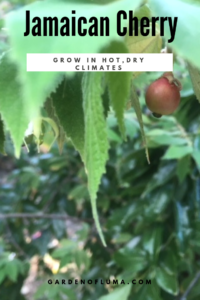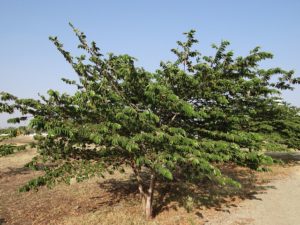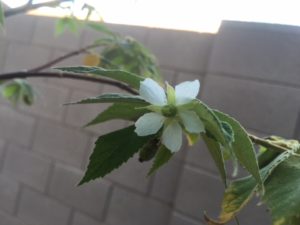Growing Jamaican Cherry in Hot, Dry Climates

I’m always looking for plants and trees that will get my kids excited about gardening. I believe that gardening is such a worthwhile experience for kids that teaches so many valuable lessons. If you’re looking for an amazing fruit tree that your kids will love, try a Jamaican Cherry tree (Muntingia Calabura). It is fairly easy growing Jamaican Cherry in hot, dry climates.
Jamaican Cherry trees really do well in our desert heat and don’t seem too bothered by our intense sun. When the temps are favorable, Jamaican Cherry trees are rapid growers.
I purchased my tree as a small starter plant through a mail order. It was only around 6-inches when I received it. I potted it up and basically watched it grow in front of my eyes.
It easily grew 8 feet in the first year and I’ve heard of them growing as much as 14 feet.
I don’t believe that there are any additional variety types and they are mostly propagated by cuttings.

Fruiting
Even though it has the word cherry in the name, the fruit isn’t really cherry like. The fruit looks similar to a cranberry in size and appearance, but more of a pink color, than deep red.
The tree fruits abundantly and always seem to have cherries on the tree. The blossoms look really similar to a strawberry blossom, so the tree is also known by some as Strawberry tree.
The cherries will ripen throughout the warm months and can stay green for long periods of time. I’ve noticed when we get times of slight humidity, the berries tend to ripen quick.
The cherries taste a lot like cotton candy, which is what makes the tree so much fun for kids. My kids call it the cotton candy berry.
The birds really love these as well so you may have to either beat them to it or find a way to deter them.
Gardening Skill Level
I would say that growing Jamaican Cherry in a hot, dry climate is for beginner to moderate skill level. The main challenge with it is cold.
It is really easy throughout the hot months of the year and doesn’t take much special care. It doesn’t require any shade protection.
They often start producing in their first year, so you don’t have to wait several years to get fruit.
You will have to have some sort of plan to protect it when temps start dipping into the low 30’s Fahrenheit.
Suitable for Container Growing
Since Jamaican Cherry grows so rapidly, growing it in a container isn’t ideal. I’ve seen a lot of Jamaican Cherry trees killed in our climate during our light frosts, so I decided to grow mine in a container.
When growing this tree in a container, be prepared to prune regularly. I prune a few times throughout the year, so don’t be afraid to chop this tree back.
I’ve found that the container does start to slow the growth down a bit. Since the roots fill the container pretty quickly it makes it a challenge to keep it watered in the hot months.
I need to water it daily, sometimes morning and evening when temps are extreme. I’ve been surprised at how well this tree has done in a container.

Planting Tips
I’ve read that Jamaican Cherry trees are fairly salt sensitive, but I haven’t seen too many issues with that. If planting in the ground in high clay soil, it may be a good idea to amend the soil.
Here is my post on soil amending. I’d periodically deep water the tree to flush the salts and be careful with synthetic fertilizers that can burn easily.
It’s a good idea to take in consideration that this tree can get large quickly, so plan accordingly when identifying the right spot in your yard.
If planting in the ground, think about a spot that stays the warmest through the winter, you won’t have to worry too much about the summer heat.

Watering
My Jamaican Cherry tree loves a lot of water. Typically when you start seeing yellow leaves, you think that it’s getting too much water, but it’s actually the opposite with Jamaican cherry.
It took me a little while to figure that out. I water my Jamaican Cherry tree daily in the summer heat, but it is in a container. If I miss a day, it shows in the tree.
I don’t see this tree being a very drought tolerant tree, so it needs consistent irrigation. If in the ground, it probably doesn’t need daily watering, but it’ll still need a few times a week during the hot months.
Feeding
I provide routine feeding to my Jamaican Cherry tree with fish emulsion and liquid seaweed. It doesn’t seem to be very picky about feeding.
Even though it is a fast growing tree, it doesn’t seem to be a heavy feeder or have any extra feeding demands.
I haven’t noticed too much of an issue with salt burn. I also periodically feed with my compost throughout the year.
Sun Exposure
Jamaican Cherry tree seems to handle full sun very well. It’s a tree that can pretty much be planted anywhere in the yard without any worry of problems with sun exposure.

Potential Problems
Other than birds gravitating towards the fruit, I don’t have a lot of pest problems with this tree. The main thing that was an issue early on for me, was determining what caused the yellow leaves.
If you adjust your watering and understand that it’s a normal part of growing this tree, then you’ll be fine. I’ve found that trees that grow rapidly, like the Jamaican Cherry tree also tend to cycle through leaves more frequently, which can also be part of the yellowing on old leaves.
I’ve read a lot about Jamaican Cherry trees and haven’t really been able to find a clear answer on how much cold they can handle.
Like I mentioned earlier, it does seem like Jamaican Cherry can tolerate some cold, but may not be able to take as much as most subtropicals.
It’s a good idea to factor this in when planting this tree to determine the right spot to plant or if you want to attempt to grow in a container.
Please comment below on anything you enjoyed from this post and your experiences with growing Jamaican Cherry.

Very useful information. Just received this plant in New England and was wondering about humidity if they could take lower levels. So I know now if you can grow them in AZ I know I won’t have a problem. Thank you!!
Thanks! Yeah they grow well in both humid and arid climates.
we will cultivate it in India